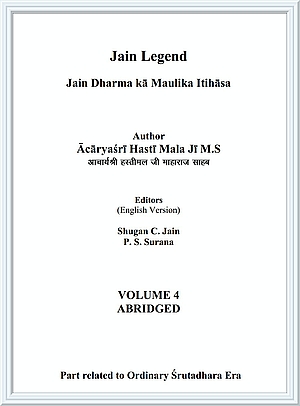In Kharaṃṭiyā, a city in the desert region (Rajasthan), Mehatā Kāmadāra, working as Bīsā Oswala of Jāgīradāra Durjana Siṃha of Jodhā dynasty had two sons. The elder son was Mehatā Jīva Rāja and the younger Mehatā Lakhamasī. The two brothers owned immense wealth and riches, and were followers of Kharatara gaccha, and well conversant in Jain doctrines like Jīvājīva etc. Due to some reason Durjana Siṃha, son of Ratana Siṃha and grandson of Rāva Jodhā became angry with both the brothers and confiscated their property. The brothers wandering through many places to establish business reached Pāṭaṇa. There in the lodgings, both of them saw Khemacandra, the disciple of Ācārya Ānanda Vimala Sūri of Pūnamiyā gaccha, writing Daśavaikālika Sūtra. The younger brother Lakhamasī took some papers and Sūtras from Monk Khemasī and wrote some verses like 'Dhammo Maṃgala Mukkiṭṭhaṃ' etc. Monk Khemasī was so delighted with the beautiful handwriting of the stranger. At once he went to his guru and showed the paper written by Lakhamasī. Impressed and surprised at the beauty of the letters, the preceptor asked, "Who has written this?"
Monk Khemacandra brought both the brothers to his Guru and signalling at Lakhmasī said, "Lord! This is Lakhamasī, who wrote those verses."
With the auspicious commencement of Vikram 1531 the amoral consequences of Bhasmagraha (asterism of ashes) had disappeared. Ācārya Śrī assigned the work of copying the Sūtras to Jīvarāja and Mehatā Lakhamasī. While copying the Sūtras, Lakhamasī came to know that the real form of asceticism described in the scriptures was extremely pure and non- transgression. He realised that the current (of his times) Śramaṇas completely deviated from the pure path and were performing many pompous external rituals which involve violence in the name of Dharma. With an object to collect the treasure of scriptures, Mehatā Lakhamasī met the businessman 'Rūpasī' and requested for financial assistance for copying the scriptures. He copied and got 32 scriptures copied by other scribes. Thereupon Rūpasī and Lakhamasī studied the scriptures under Ānanda Vimala Sūri. After becoming a great scholar in scriptures Lakhamasī (Lokāśāha) gave sermons at Tripoliyā in Pāṭaṇa and started showing the real portrait of Dharma.
Awakened and enlightened by the preaching of Lakhamasī (Lokāśāha) 45 detached souls like Rūpasī, Śāha Bhāmā, Śāha Bhāramala and others, took initiation into monkhood on Thursday, the bright 11th day of Vaiśākha month in Vikram 1531 and established Lokā gaccha. Rūpasī was appointed as the first pontiff successor; Bhāramala and Bhujarāja (Bhojarāja or Bhāmājī) were ordained as Sthaviras. Lokā gaccha gained momentum.
It appears that Monk Rāyacandra (Vikram 1726), the author of Pātariya gaccha Paṭṭāvalī alone was the victim of total inauspicious effects of (bad planetary conditions) Bhasmagraha. Or else why had he penned such baseless things? There is nothing worthy to be considered in this Paṭṭāvalī, except one new thing, i.e. Lokāśāha belonged to Mārawāḍa, Kharaṃṭiyā or Virāṃṭiyā village and was of Bisa Oswala caste. In Mārawāḍa, persons engaged in estate business were called as 'Mehatā'; however it cannot be ascertained that Lakhamasī belonged to Mehatā family.
Political conditions from Vikram 1357 to 1382
During the regime of Khilajī dynasty in Delhi, Allāuddīna Khilajī wanted to establish his authority over Rājapūtānā. As a first step towards this direction he invaded on Raṇathaṃbhaura in Vikram 1357. King Hamīra of Raṇathaṃbhaura opposed audaciously. However, after a fierce battle, Allāuddīna Khilajī defeated and captured Raṇathaṃbhaura. Thus the Cauhāna kingdom established by Govindarāja, the son of Pṛthvīrāja Cauhāna in Vikram 1250 came to an end in Vikram 1357.
3 years after establishing authority over Raṇathaṃbhaura, Allāuddīna Khilajī invaded Cittauḍa with a huge army in Vikram 1360. Rāwala Ratanasiṃha of Mewāḍa, with amazing valour and undaunted courage, waged war against the Khilajī army continuously for 6 months. Ultimately Rāwala Ratanasiṃha, along with his sons, grandsons, kith and kin - Saradāras and Rājapūta warriors - donning of saffron robes opened the gates of Cittauḍa and fiercely attacked the enemy, prepared to stake their lives for their motherland. Fighting valiantly till the last breath, Rāwala Ratanasiṃha along with his sons, grandsons and warriors et al sacrificed his life protecting his motherland. When Padminī Devī, wife of Rāwala Ratanasiṃha was informed that her husband along with his warriors embraced heroic death slaughtering the enemy's force, she too with thousands of Rājapūta women performed self-immolation and saved the pride and honour of Rājapūtas. Allāuddīna established his authority over a necropolis-like Cittauḍa and appointed his son Khijara Khāna as its ruler.
After invading and annexing Cittauḍa, Allāuddīna besieged the fort of Sivāṇā in Vikram 1365. The King Śītala Deva Cauhāna, defending his fort died in the battlefield. Thus Allāuddīna occupied this territory too. Next he attacked Jālaura in Vikram 1368. King Kānhaḍa Deva and Prince Vīramadeva fought bravely devastating the enemy force, but both died in the battlefield defending their fort. Allāuddīna annexed and established his authority over Jālaura. Thus the great Rājapūta kingdoms Raṇathaṃbhaura, Sivāṇā and Jālaura came to an end.
Mahārāṇā Hamīra defeating the Muslims established his authority over Cittauḍa in Vikram 1382.
The subsequent political events like riots, invasions by Muslims, fall of Hindu kingdoms, origin of new Hindu dynasties, glory and decline, forcible religious conversions at sword point, plunder, loot, confiscation, holocaust etc. are filled with multiplicity of such events that even if only 5 lines are written on each event, it forms a separate historical text in itself.
The size of the present series has grown so large that we stop here and bid farewell to the readers at this juncture and humbly request the readers to read the subsequent Jain and India history and events in the concerned texts.
 Acharya Hasti Mala
Acharya Hasti Mala
